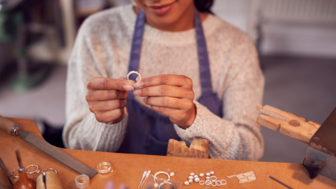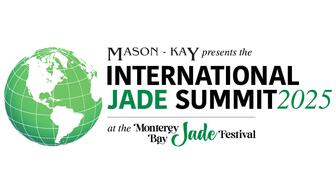Bonhams will offer the “Kat Florence Lumina” at its May 22 jewelry auction.
A Quick Review of the FTC’s Rules on Lab-Grown Diamonds
Our Editor-in-Chief Michelle Graff offers a refresher following the Federal Trade Commission’s distribution of eight warning letters regarding advertisements for lab-grown diamond jewelry or diamond simulants.

The distribution of these letters comes less than a year after the commission’s long-awaited overhaul of the Jewelry Guides, the FTC-created rulebook that outlines the terms marketers should, and shouldn’t, use to describe jewelry to consumers.
When the new Jewelry Guides dropped last summer, it seemed, to me anyway, that many lab-grown diamond companies perceived the revisions to be a big victory for them, perhaps bigger than it actually was. They’ve since gone a little overboard with their marketing, either thinking that it was allowed or that nobody was watching or would notice.
But that, apparently, is not the case.
The FTC is paying attention and is interpreting the revised guides more strictly than some had expected, including Jewelers Vigilance Committee President and CEO Tiffany Stevens, whose organization is tasked with (among many other things) keeping the industry’s advertising in check.
Stevens told me in an email Thursday that, “We are extremely encouraged that the FTC is putting focus on our industry in this way at this time. The guides had not been updated since the ‘90s, and in our conversations with the FTC, we emphasized that the update really wasn’t complete until they took some enforcement action to demonstrate the meaning and limits of the new guides.
“We were seeing evidence of some players really creating their own reality and running wild beyond any reasonable interpretation of the new guides. We would reach out to stem the action and also see incidents in our mediation practice, but there is nothing like having such a loud and clear action from the federal government itself.”
All this being said, I thought in light of this week’s events, now would be a good time for a refresher on the FTC’s Jewelry Guides as they pertain to man-made diamonds and simulants.
1. If a product is a lab-grown diamond, then the fact that it is man-made must be clearly and conspicuously stated.
The FTC made the change to the definition of a diamond in its Jewelry Guides before the section on diamonds as a way of saying: We will lay out the guidelines in this coming section that apply to diamonds, and by diamonds we mean “a mineral consisting essentially of pure carbon crystallized in the isometric system” that was either mined from the earth or grown in a factory.
Nothing changed about how lab-grown diamond companies, and sellers of lab-grown diamonds, have to describe the product to consumers.
The FTC says they still must make it clear that the product is man-made by using “clear and conspicuous” disclosure with the word diamond; the three terms the FTC recommends using are laboratory-grown, laboratory-created or [manufacturer name]-created.
Cultured is OK too, but it has to be “immediately accompanied, with equal conspicuousness” by one of the three terms; it cannot stand alone.
When “diamond” appears by itself, it still means a natural diamond.
And those three qualifying terms mentioned above, the FTC noted this week, must be “proximate” to the product description, not in a place where consumers aren’t likely to see them. It mirrors the rules the commission has laid out for paid posts by influencers, who are supposed to write “#ad” where people can see it, not bury it in the middle of a caption.
Companies cannot relegate disclosures to FAQ or education pages, with FTC Consumer Education Specialist Bridget Small noting in a blog published on FTC.gov Tuesday: “Some businesses only put information about how a stone was really made on a ‘diamond education’ webpage, rather than in or near an ad where shoppers were more likely to see it.”
2. Social media is a not a free-for-all.
The FTC reminded companies that the Jewelry Guides and the truth-in-advertising provisions of the FTC Act apply on Instagram, Facebook and Twitter, too.
Frisby also urged marketers to be cautious when using hashtags, for two reasons.
First, if a marketer wants to use a hashtag for disclosure purposes—e.g., #labgrown—they have to consider the overall impression of the advertisement. Is that hashtag making it obvious enough to consumers what the product is?
Secondly, marketers need to be mindful of making claims with hashtags. For example, #diamonds might imply that a product is mined, since the FTC still considers “diamond” alone as referencing a mined diamond.
3. CZ and moissanite aren’t the same thing as diamond (either natural or man-made), and that must be clear too.
In addition to the ads for lab-grown diamonds, the FTC noted that it spotted advertising for simulated diamonds that implied the stone was either a lab-grown or mined diamond.
The commission “encourages” companies selling simulated diamonds to avoid describing their products in a way that “falsely implies” what they are selling has the same optical, physical and chemical properties as mined or lab-grown diamonds.
4. Be cautious when making “eco” claims.
For example, if a company is claiming its product is “eco-friendly” because it’s recyclable, or because it takes measures to use less energy or less water in the manufacturing process, then the ad has to state this. It can’t just state “eco-friendly” because there are too many ways consumers can interpret that.
In addition, companies need to have publicly available evidence backing up their claims, and the amount of scientific evidence that’s needed increases with certain claims, such as “carbon neutral.”
The FTC has an entire rulebook dedicated to “eco” claims, separate and apart from the Jewelry Guides. It is called the “Green Guides” and can be accessed on FTC.gov.
The JVC’s Stevens added a point I’ve made in writing about lab-grown diamonds on this blog before: a product cannot be labeled as “green” or “eco-friendly” simply because it is perceived to be “greener” than the same product next to it.
She explained it like this: “One of the recurring issues we see with the environmental claims is the use of relative standards (i.e., Michelle speaks 20 words of Spanish and Tiffany speaks one so Michelle is fluent in Spanish) rather than what the standard actually is under the [FTC’s] Green Guides, which is an absolute (i.e., Michelle is either fluent in Spanish or not, regardless of how competent the person standing next to her is.)”
Before I wrap up this blog, it’s worth noting that the FTC is not a law enforcement body; no one is going to prison for putting out diamond jewelry ads that violate the FTC’s Jewelry Guides.
However, the commission can levy fines, and, what might even be worse for these companies, the commission publicizes when it writes warning letters, which can result in coverage not just from trade press but consumer press as well.
Reuters picked up the story about the FTC’s warning letters, as did Ad Age.
The story even made it onto Page Six of the New York Post, which ran it with the headline, “Leonardo DiCaprio-backed diamond company accused of false advertising,” zeroing in on the Diamond Foundry.
The FTC is not disclosing the names of the seven other companies that received warning letters without a Freedom of Information Act request.
A spokeswoman for the Diamond Foundry said the company is limited as to what it can say at this point, but released the following statement: “We have received an inquiry from the FTC, which we take seriously and will respond to in comprehensive detail. We pride ourselves on being a lab-grown diamond producer, and this point of differentiation is what our success is built on. We have worked collaboratively with the FTC for years, and the FTC has been a great supporter of the industry and a champion of change for consumer transparency.”
The FTC is giving the companies it contacted 10 days to let the commission know how they plan to alter their advertising.
The Diamond Foundry said it will share follow-up information when available.
Stay tuned. I bet this isn’t the last we’ll hear from the FTC regarding the revised Jewelry Guides.
The Latest

In March 2022, the men went into a jewelry store in Beverly Hills and smashed the display cases with sledgehammers and crowbars.

The 51 unique watches from Sotheby’s three-day sale and immersive exhibition all found buyers, with the top lot selling for $229,955.

The company has acquired Australian jewelry insurance provider Jewellers Loop.


Beau Lotto’s immersive presentation will be a blend of neuroscience, art, and entertainment.

A pink topaz Belle Époque pendant-brooch and a Victorian Egyptian Revival choker were also highlights at a recent Anderson & Garland sale.

Bench jewelers spend years honing their skills, Jewelers of America’s Certification validates their talents.

The event, which will co-locate with the Monterey Bay Jade Festival, will bring education sessions focused on jade to the United States.

The charm is a celebration of springtime as April showers bring May flowers with the piece’s cluster of diamond raindrops.

The National Retail Federation expects retail sales growth to return to pre-pandemic levels as consumers continue to face inflation.

The 4-carat, old mine brilliant-cut diamond engagement ring was co-designed by Willis and New York City-based brand Karina Noel.

Rio Tinto unearthed the diamond at its Diavik mine in Canada’s Northwest Territories.

The multisensory experience, open April 8-13, will feature the brand’s silver creations among dream-like scenes of natural landscapes.

The virtual event will take place April 7 at 3 p.m.

The pieces in “Animali Tarallo” portray animals from stingrays to elephants through portraits and interpretations of their patterns.

Parent company Saks Global said the iconic location will be open through the holiday season as it decides what to do with the space.

Ronald Winston, son of Harry Winston, donated the diamonds to the Smithsonian National Museum of Natural History in Washington, D.C.

The educational event will take place in Charlotte, North Carolina, this May.

The independent jeweler first opened its doors in 1888.

The layoffs come amid the TV shopping channel’s efforts to restructure and focus on live shopping through social media.

The debut event will take place in Miami’s Coconut Grove neighborhood this fall.

The roundtable will take place May 17 ahead of the trade show’s welcome dinner.

The “Peanuts x Monica Rich Kosann” collection features the comic strip’s classic vocabulary across 10 bracelet designs.

Three industry experts dive into the complexities of the material often marketed as an “ethical” alternative for metal in jewelry.

Diamonds are not only one of the most prominent gemstones, but the birthstone for those born in April.

The Utah-based company known for making wedding bands has acquired Doubloon Golf.



























